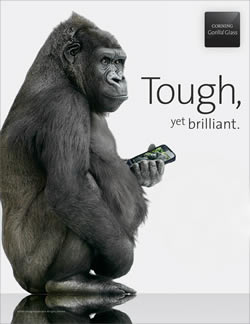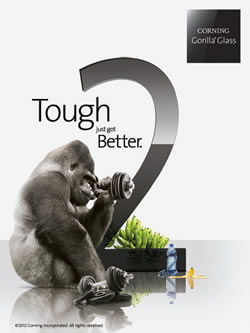Difference between Gorilla Glass 1, 2 and 3
Key Difference: Gorilla Glass is a kind of toughened glass that is developed by Corning Inc. It is scratch resistant, and damage resistant. Despite this, it is also very thin and light. Gorilla Glass 2 is a better version of Gorilla Glass, while Gorilla Glass 3 is better than both of them.

Gorilla Glass is a kind of toughened glass that is developed by Corning Inc. This glass has many advantages. It is scratch resistant, and damage resistant. Despite this, it is also very thin and light. All these factors make Gorilla Glass ideal for use in displays of consumer electronics. As anyone who has ever had a smartphone and accidentally cracked the screen on that smartphone knows, smartphone screens are very easy to crack. Hence, devices such as smartphones, tablets, laptops, MP3 players, DVD players, and even televisions, need a sort of protection on their screens, which is what Gorilla Glass provides.
Gorilla Glass is an alkali-aluminosilicate sheet toughened glass, which means that it is made by immersing the glass sheet in a molten alkaline salt bath. This then uses ion exchange to reduce the glass’s tendency to crack. The uses ion exchange creates compressive residual stress at the surface. In order for a crack to form, the residual stress must be overcome.
 This process of creation allows the glass to be thin while still being scratch and impact resistant. This thinness means that it won’t interfere with capacitive touch screens. It will also be lightweight and hence not add weight to the electronics, which would work against the portability of the device.
This process of creation allows the glass to be thin while still being scratch and impact resistant. This thinness means that it won’t interfere with capacitive touch screens. It will also be lightweight and hence not add weight to the electronics, which would work against the portability of the device.
It might be difficult to believe that Gorilla Glass developed out of "Chemcor" glass, which was developed by Corning as part of a "Project Muscle" initiative in the 1960s. Chemcor was used widely in various industry application including automotive, aviation and pharmaceutical uses. Gorilla Glass was lead into developemnet when Apple Inc. asked for a toughened glass to go into its iPhone.
Corning has continued to develop their Gorilla Glass, eventually leading to the release of Gorilla Glass 2 and Gorilla Glass 3. The original Gorilla Glass was touted for its high scratch resistance and its hardness, while still being thin. Gorilla Glass 2 built up on that and was 20% thinner than the original Gorilla Glass.

Then came the Gorilla Glass 3, which was created by using a modified development process. This resulted in the Gorilla Glass 3 being up to three times more damage-resistant than Gorilla Glass 2, as well as being 40% more scratch-resistant. It was also more flexible and incorporated a silver ion doping that killed up to 90% of bacteria.
Another advantage of Gorilla Glass in general is that it is completely recyclable. After use, Gorilla Glass is pounded into power, which can then be used to make other things.
Comparison between Gorilla Glass 1, 2 and 3:
|
|
Gorilla Glass 1 |
Gorilla Glass 2 |
Gorilla Glass 3 |
|
Company |
Corning Inc. |
Corning Inc. |
Corning Inc. |
|
Introduced |
2007 |
2012 |
2013 |
|
Advantages |
|
|
|
Image Courtesy: fishandbicylces.wordpress.com, corning.com, phonesreview.co.uk









Add new comment